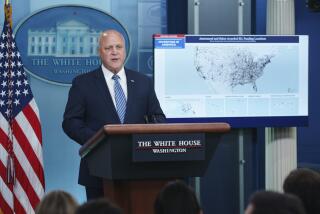High-Speed Computer Networks Urged as Boon to Business, Schools
- Share via
ATLANTA — Imagine cranking up a personal computer at home and calling up every page of every book in the Library of Congress. Including pictures. Or transmitting an entire Encyclopedia Britannica from one computer to another, anywhere in the country--in one second.
These and myriad other possibilities are envisioned by proponents of massive networks linking millions of computers that could transmit data at speeds many times faster than existing transmission lines.
BACKGROUND: Proponents of these computer networks call them “information superhighways” and liken their potential importance to the impact of the interstate highway system on postwar America.
Using fiber-optic technology, they would link the nation’s fastest, most powerful computers to businesses, schools, research centers--and eventually, to homes. The networks could allow virtually instantaneous two-way communication in print and video, compressing time and distance, and giving the country a big competitive boost.
For example, complicated designs could be raced from conception to computer tests to factory floor in a fraction of the time needed now by using such networks.
The U.S. Senate recently approved a bill by Sen. Albert Gore Jr. (D-Tenn.) that would provide $1 billion over a five-year period to develop the supercomputing network, including hardware, software, education and research.
The project would be called the National Research and Education Network and would replace the slower Internet, a group of 2,000 commercial, academic and government networks.
In the view of Gore and other supporters of the new network, the world gathers far more information than it can disseminate over existing computer networks. This leads to what Gore calls “rotting data,” comparing the situation to storing grain in silos and allowing it to go bad.
Gore, the chairman of the Senate Commerce Committee’s subcommittee on science, technology and space, warned against foot-dragging on construction of the networks, lest other nations beat America to the technology.
To be sure, the Japanese and Europeans are working on their own networks. Japan has announced a $250-billion government program spanning 25 years. But a September report by the General Accounting Office said some European officials believe that Europe “currently lacks a cohesive central organizational structure and a supportive regulatory environment” to guide the project. Japan’s success may depend on “how well the networks compete with other programs for government funding,” the GAO said.
Critics of U.S. efforts question expenditure of government funds, asserting that private communications firms should foot the bill.
Gore says federal leadership is needed to start the network, much like it was needed to build interstate highways, and that eventually fees could be charged to users of the computer network, similar to road tolls.
Another GAO report, published in July, “Industry Uses of Supercomputers and High-Speed Networks,” said networks already in use (mostly private, slower lines than those envisioned in the new network) improve productivity and earnings by enabling industries to overcome long distances as they share information and collaborate on the development of products.
BARRIERS: At the same time, the report cites barriers to the increased use of supercomputers, defined as the most powerful computers available at a given time. Among the barriers are high cost and “cultural resistance.”
John Coman, manager of networks and information services at Atlantic Richfield Corp. in Los Angeles, said the new networks also face obstacles because “private industry is fundamentally suspicious of anything the government does because it is always a day late and $10 more expensive than it should be.”
Some experts believe schools would be the biggest beneficiaries of the networks.
In Research Triangle Park, N.C., Lawrence Lee, executive director of the North Carolina Supercomputing Center, said the idea could be a “tremendous benefit to the educational community” because it would allow unprecedented sharing of resources nationwide as students in poorly equipped schools electronically hooked into institutions with more resources, such as textbooks, library books and other materials.
Coman agreed, saying that “instead of having (the materials) in every place, you could move things back and forth.”
Staff researcher Edith Stanley contributed to this story.
More to Read
Inside the business of entertainment
The Wide Shot brings you news, analysis and insights on everything from streaming wars to production — and what it all means for the future.
You may occasionally receive promotional content from the Los Angeles Times.










